Items
Site
The Medicine Chest
keywords is exactly
specimen
-

Foxgloves
Called variously foxgloves, witch’s gloves, dead men’s bells, fairy’s gloves, bloody fingers, gloves of our lady, fairy caps, virgin’s gloves or fairy thimbles, Digitalis purpurea is popular with children, who pluck the tempting bell-shaped blooms and wear them like thimbles, admonished not to lick their fingers afterwards for fear they will go blind (Young 2002: 57). While the flower can be lethal if ingested, the drug digitalis derived from foxglove is most commonly used as a heart stimulant. Digitalis has been prescribed since the 17th century, perhaps earlier, as a diuretic and to slow the pulse and is still the drug of choice for atrial fibrillation. In the 1770s, William Withering got an old family recipe, a herbal infusion for treating swollen legs, from a Shropshire woman and identified digitalis as the active one of the twenty ingredients. Many more antiarrhythmic drugs now exist (Young 2002: 57). Made up of surgical gloves, Band-Aids, syringes and IV-tubing (with an infusion of foxglove leaves in its stem) the work mimicked the language of the herbarium specimen, drawing a viewer in to examine the content they were expecting, only to surprise them with its incongruous materials. -
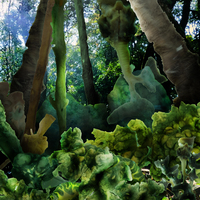
A 'Jungle'
"A ‘jungle’ consisted of a selection of pathological specimens from the Pathology Learning Centre that had been affected by typhoid fever, ascaris adult worms, yellow fever, amoebic ulcerations, tuberculosis and malaria. The diseases that afflicted these specimens were regarded as ‘tropical’. As described in Chapter One, BWC used the jungle as a significant terrain that called for a medicine chest to combat pathogens: ‘Whether you were valiantly saving your compatriot in war, traversing a dark African jungle, navigating one of the world’s first flying machines, exploring the most desolate place on earth, ascending the highest mountain in the world, or simply enjoying the windswept British coast, the chest would be there, ready for any ailment’ (Johnson 2008b: 255). BWC promoted their chests as the ideal antidote for a tropical landscape ‘at once full of potential wealth for imperial Britain, but simultaneously rife with disease’ (Johnson 2008b: 258) and claimed that the tropical colonies were ‘by far the most dangerous regions for travellers’ (BWC 1934: 8). It was here that ‘desolating ailments’ were encountered, all ‘particularly fatal to the so-called white man who originates in temperate climates’ (BWC 1934: 8). I adapted the colour of the images of afflicted intestines, livers, stomachs and brains and used them as material to construct a dense jungle that referenced this aspect of the medicine chest’s history. Printed on separate glass sections that fit into the cabinet at spaced intervals to create an illusion of depth and three-dimensionality, the work draws on the cross-sectional display technique used in many anatomy museums worldwide, in projects such as the Visible Human Project (1995) and that the artist Damien Hirst references in his works . Creating a visual link between the UCT specimens and the history of these diseases surfaces the occluded racial undertones of these understandings" (Liebenberg 2021: 267). -
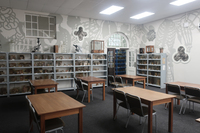
Subtle Thresholds (PLC)
"Integrated into the PLC, these works speak to the specimens on display and provide interesting access points to the collection. The animal-faeces prints (which referenced ‘sites of contamination’ in the context of the SAM exhibition) resonate, for instance, with many of the specimens on display in the PLC, such as the heterotopic heart (also called a ‘piggy-back heart transplant’) created by Dr Chris Barnard in 1977, consisting of a baboon heart grafted onto a human heart for additional motoric support. In addition to their more ‘famous’ specimens, the centre also has an extensive intestinal worm collection and many organs affected by zoonotic diseases, such as a liver ravaged by malaria. This was not a conscious decision on the part of the artist-curator and illustrates how curation can draw attention to aspects of a collection and liberate new associations when brought into conversation with it" (Liebenberg 2021: 201). -
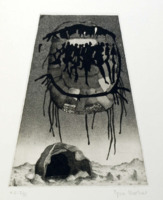
Etching from 'Sound from the Thinking Strings'
"Skotnes’s own visual interpretation of the history and cosmology of the |xam formed the last component of this interdisciplinary endeavour and constituted a visual component that drew together the various strands of disciplinary interpretations and presented a perspective on the |xam life she felt ‘was missing from the other interpretations’ (Skotnes 1991: 30). In these images she drew freely on San mythology, accounts of |xam life recorded by Lucy Lloyd, historical and archaeological research and images from rock paintings in a landscape setting. She writes in her preface that these etchings were direct attempts at ‘inverting the museum dioramas’ in the ethnographic halls close to the exhibition and which, through their display of the San’s body casts, rendered them closer to specimens of biology than as members of a highly developed culture (Skotnes 1991: 52). By creating images that combined shamanistic rituals, entoptic spirals, plants, hunting bags, bows and arrows, snakes, eland-shaped rainclouds, colonists, musical instruments, shelters and therianthropic shapes, Skotnes eclipsed the static narratives of the dioramas and the object labels in the exhibition, placing them in a context in which their metaphysical qualities were celebrated more than their physical qualities. These prints stood in striking contrast to the other exhibits, which framed the San as physical types, and they challenged viewers to confront the reality that the San had a rich history and cultural and social life" (Liebenberg 2021: 157). -
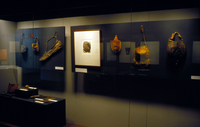
Sound from the Thinking Strings (installation detail)
"Skotnes had a longstanding relationship with the museum, which started when she was still a student at the Michaelis School of Fine Art. Davison remembers that Skotnes would visit the taxidermy section of the South African museum to draw bones. As an anthropologist, Davison admits to finding Skotnes’s way of looking at things stimulating – an individual way of looking at objects that made her look at them differently, even though she was already very familiar with these materials. Davison recalls a visit to the ethnographic stores during which she showed Skotnes the San skin bags, carefully conserved in their drawers and laid out on acid-free paper. Skotnes admired not only their aesthetic qualities but related the stories she had been studying in the Bleek and Lloyd archive to them – stories that shifted their status from anthropological museum objects to powerful animate objects in San spiritual and social life (P. Davison, personal communication, 28 January 2021). Skotnes remembers that she asked staff whether they knew what was inside the bags and was shocked when nobody could remember looking in them. She was allowed to look inside one and found a claw, which they thought must be a leopard’s (P. Skotnes, personal communication, 9 May 2021)" (Liebenberg 2021: 2015). -
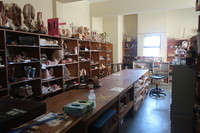
The workshop
"Held in the Department of Human Biology in the Division of Clinical Anatomy and Biological Anthropology, this collection consists of prepared specimens – both bottled and plastinated, anatomical models – and a skeletal repository used for research purposes. The materials are kept in three separate rooms, with the anatomical models in one, the prepared and plastinated specimens in another and the skeleton repository in its own room behind locked doors, viewable by appointment only. The room housing the anatomical models functioned as a workshop when modelmaking was still offered to first year medical students as an elective course: its walls are lined with shelves that display models made from materials ranging from papier-mâché to modern silicon copies and are taxonomised according to their anatomical representations, such as ‘the eye’, ‘head & neck’, ‘dentistry’, ‘embryology’, ‘lungs’ and ‘cardiovascular system’, to name a few. The models represent each anatomical section and are brightly coloured to differentiate the different parts of the human body and aid in identification. Many of the models can be dismantled into separate pieces and, like a puzzle, be reassembled into their original shapes. Interspersed with these models are rolled-up charts depicting organs, bodily systems and anatomical sections of the body in two-dimensional form, as well as old student modelling projects. A selection of animal skeletons is displayed on the far side of the room, and a shelf with a few anatomical specimens in formaldehyde is across from it" (Liebenberg 2021: 121 - 122). -

Second star to the right and straight on 'til morning
Cyanotype on paper. Ink on perspex. The work shows the exact positioning of the stars from J.M. Barrie’s window at 3 Adelphi Terrace, London (51°30'N 0°7'21"W), on Saturday, 19 June 1937 – the night of his death. Based on the direction of his window, I was able to locate the ‘second star to the right’ at the 45 degree angle he would have stood and viewed the night sky. Hopefully, he reached his destination, after departing the flat and traveling ‘straight on till morning’. -
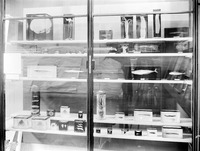
Terra Nova
Robert Falcon Scott’s Terra Nova expedition reached the South Pole on 17 January 1912 — 23 days too late. Inside a small tent supported by a single bamboo flying a Norwegian flag, was a record of the five who had been the first to reach the pole: Roald Amundsen, the leader, and his team - Olav Olavson Bjaaland, Hilmer Hanssen, Sverre H. Hassel and Oscar Wisting. On 19 January, they began their 1,300 kilometre journey home, Scott writing: “I’m afraid the return journey is going to be dreadfully tiring and monotonous” (Scott 1914: 548). -

Fish
A showcase of fish found in the Artic regions. -

Echolocation (Part one)
In the spring of 1940, Steinbeck and his very close friend, biologist Ed Ricketts, chartered a boat and embarked on a month long marine specimen-collecting expedition in the Gulf of California, which resulted in their collaboration on a book, 'The Sea of Cortez'. Described as both a travelogue and biological record, it reveals the two men's philosophies: it dwells on the place of humans in the environment, the interconnection between single organisms and the larger ecosystem, and the themes of leaving and returning home. A number of ecological concerns, rare in 1940, are voiced, such as an imagined but horrific vision of the long term damage that the Japanese bottom fishing trawlers are doing to the sea bed. Although written as if it were the journal kept by Steinbeck during the voyage, the book is to some extent a work of fiction: the journals are not Steinbeck's, and his wife, who had accompanied him on the trip, is not mentioned (though at one point Steinbeck slips and mentions the matter of food for seven people). Since returning home is a theme throughout the narrative, the inclusion of his wife, a symbol of home, would have dissipated the effect. Steinbeck and Ricketts are never mentioned by name but are amalgamated into the first person "we" who narrate the log. -

Lotus Leaves (Full Leaf)
"Gabriel Orozco's interest in the natural world and its relationship with humans inspired him to have actual lotus leaves etched into the printing plates, creating a man made yet true rendering of the leaf. Every vein, tear, and insect bite was captured and imprinted on special custom milled Gampi paper matching the hues of the leaf. The proofs were made as chine collé soft ground etchings, individually cut to the shape of each leaf. Orozco had a revelation while holding one of the tissue thin leaf prints up to the window: the exquisite purity that he was seeking was best displayed deconstructed and suspended in glass, illuminated all around, like a delicate specimen. The somewhat unorthodox technique used for this edition was an exciting challenge that resulted in a series of lifelike images that honors the natural world "(Lapis Press 2021). -
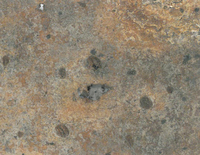
Skin
I collected leaves from the gardens around Groote Schuur Hospital and gave them to UCT dermatologist Ranks Lehloenya for analysis. Using the strategy of directing insider focus to an outsider object, Lehloenya treated these specimens as sections of skin and read them accordingly, highlighting sections that showed signs of nummular eczema, acne, ageing, miliary tuberculosis and melanoma, to name a few (Liebenberg 2021: 277). This example was diagnosed as follows: "This section shows characteristics which could point at various causes. The darker raised sections could be blackheads as seen in acne (note the darker central area reminiscent of an open pore); villous hair cysts ( a condition in which hair follicles are trapped under the skin to form pimple-like structures with the hair giving a dark hue in the centre; syringomas (non-cancerous proliferation of sweat glands); infections such as chicken pox or miliary tuberculosis in which the infection spreads from the blood onto the skin (miliary mean it looks like a millet seed). It could also be metastatic melanoma that has spread from another area onto this skin". -
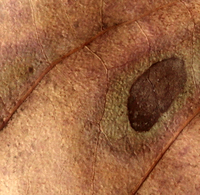
Skin
I collected leaves from the gardens around Groote Schuur Hospital and gave them to UCT dermatologist Ranks Lehloenya for analysis. Using the strategy of directing insider focus to an outsider object, Lehloenya treated these specimens as sections of skin and read them accordingly, highlighting sections that showed signs of nummular eczema, acne, ageing, miliary tuberculosis and melanoma, to name a few (Liebenberg 2021: 277). This example exhibits an annular pattern which could be an infection like a ringworm (fungus) and erythema migrans of Lyme’s disease; or inflammatory conditions like nummular eczema, erythema marginatum as seen in rheumatic fever and granuloma annulare. -

Igemfe
"The transverse flute is rarely seen among the Zulu, who, if they make and use it, call it igemfe, the name of a totally different instrument. I possess three specimens, one from Inchanga, one from Pietermaritzburg district, and one from Ixopo. The first two are open at the end opposite the embouchure, and have three finger-holes; the third is a curiously aberrant example, being closed at both ends and having four finger–holes arranged in pairs" (Kirby 2013: 179) Hornbostel-Sachs number: 421.121.32 Stopped side-blown flutes with fingerholes, Length: 291mm (11.4in), Diameter: 36mm (1.2in), Place of production: St. Michael's-on-Sea (KwaZulu-Natal, South Africa). -
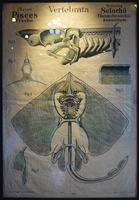
Scientific atlases
"Used from the 18th to the 20th centuries, the scientific atlases provided, for example, simplified, generalised and idealised versions of the objects of anatomy, physiology, botany, palaeontology and astronomy, to name a few, guiding the student and practitioner to what was worth looking at, how it looked and, perhaps most important of all, how it should be looked at (Daston & Galison 2007:23). The establishment and representations of these working sets of objects, and the standardised procedures for studying them, thus extended the initial influence exercised on the individual traveller in the field. By controlling the very act of seeing and by creating a sense of individuals working as members of academic communities, the atlases shaped the subjects and the objects of their disciplines. Processes initiated in the field and reinforced in institutions, societies and museums laid the foundation for procedures still used by the disciplinary insiders of university departments today" (Liebenberg 2021: 111).


